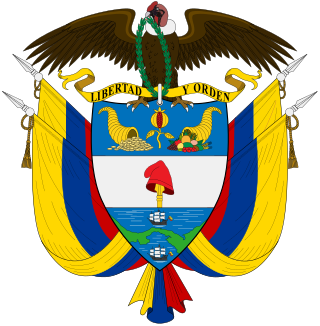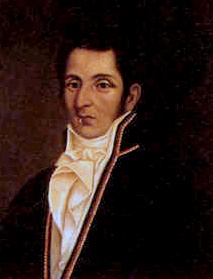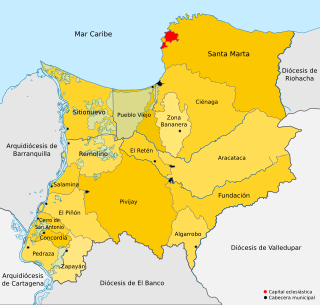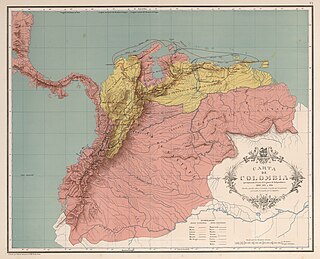
The Viceroyalty of New Granada also called Viceroyalty of the New Kingdom of Granada or Viceroyalty of Santafé was the name given on 27 May 1717 to the jurisdiction of the Spanish Empire in northern South America, corresponding to modern Colombia, Ecuador, Panama and Venezuela. Created in 1717 by King Felipe V, as part of a new territorial control policy, it was suspended in 1723 for financial problems and was restored in 1739 until the independence movement suspended it again in 1810. The territory corresponding to Panama was incorporated later in 1739, and the provinces of Venezuela were separated from the Viceroyalty and assigned to the Captaincy General of Venezuela in 1777. In addition to those core areas, the territory of the Viceroyalty of New Granada included Guyana, Trinidad and Tobago, southwestern Suriname, parts of northwestern Brazil, and northern Peru.

The national flag of Colombia symbolises Colombian independence from Spain, gained on 20 July 1810. It is a horizontal tricolor of yellow, blue and red. The yellow stripe takes up a half of the flag and the blue and red take up a quarter of the space each.

The coat of arms of Colombia contains a shield with numerous symbols. Perched on top of the shield is an Andean condor holding an olive crown and the condor symbolizing freedom. The national motto, Libertad y Orden, is on a scroll in between the bird and the shield in black font over golden background. The condor is depicted as displayed and looking to the right.
The Spanish reconquest of New Granada in 1815–1816 was part of the Spanish American wars of independence in South America. Shortly after the Napoleonic Wars ended, Ferdinand VII, recently restored to the throne in Spain, decided to send military forces to retake most of the northern South American colonies, which had established autonomous juntas and independent states. The invaders, with support from loyal colonial troops, completed the reconquest of New Granada by taking Bogotá on 6 May 1816.

Bolívar's campaign to liberate New Granada was part of the Colombian and Venezuelan wars of independence and was one of the many military campaigns fought by Simón Bolívar. Bolívar's victory in New Granada secured the eventual independence of northern South America. It provided Bolívar with the economic and human resources to complete his victory over the Spanish in Venezuela and Colombia. Bolívar's attack on New Granada is considered one of the most daring in military history, compared by contemporaries and some historians to Hannibal’s or Napoleon's crossing of the Alps in 1800 and José San Martín's Crossing of the Andes in 1817.
United Provinces may refer to:
Cundinamarca may refer to:

The First Republic of New Granada, known despectively as the Foolish Fatherland, is the period in the history of Colombia immediately following the declaration of independence from Spain in 1810 and until the Spanish reconquest in 1816. The period between 1810 and 1816 in the Viceroyalty of New Granada was marked by such intense conflicts over the nature of the new government or governments that it became known as la Patria Boba. Constant fighting between federalists and centralists gave rise to a prolonged period of instability that eventually favored Spanish reconquest. Similar developments can be seen at the same time in the United Provinces of the Río de la Plata. Each province, and even some cities, set up its own autonomous junta, which declared themselves sovereign from each other.

The Supreme Court of Justice of Colombia in Bogotá is the highest judicial body in civil and penal matters and issues of criminal and civil procedure in Colombia. The Supreme Court of Colombia is the highest authority in regard to the interpretation of administrative law, constitutional law, and the administration of the judiciary.

The Real Audiencia of Quito was an administrative unit in the Spanish Empire which had political, military, and religious jurisdiction over territories that today include Ecuador, parts of northern Peru, parts of southern Colombia and parts of northern Brazil. It was created by Royal Decree on 29 August 1563 by Philip II of Spain in the city of Guadalajara. It ended in 1822 with the incorporation of the area into the Republic of Gran Colombia.

José Custodio Cayetano García Rovira was a Neogranadine general, statesman and painter, who fought for the independence of New Granada from Spain, and became President of the United Provinces of the New Granada in 1816. He was executed a month later during the Reconquista, at the hands of Pablo Morillo.

Manuel Rodríguez Torices was a Neogranadine statesman, lawyer, journalist, and Precursor of the Independence of Colombia. He was part of the Triumvirate of the United Provinces of New Granada in 1815, and served as Vice President of the United Provinces after the triumvirate. He was executed during the Reign of Terror of Pablo Morillo in 1816.
Benito Salas Airport is an airport that serves the city of Neiva, the capital of the Huila Department in Colombia. It was named after Benito Salas Vargas, a military and social leader during Colombia's independence war (1810–1819).

The Roman Catholic Diocese of Santa Marta is a diocese located in the city of Santa Marta in the ecclesiastical province of Barranquilla in Colombia.

The Magdalena campaign was a military operation from late 1812 to early 1813, led by the independentists Simón Bolívar and Pierre Labatut against royalists and the crown of Spain in New Granada. The campaign resulted in the revolutionary United Provinces of New Grenada taking control of the Magdalena River, which connects the port city of Cartagena with the interior of Colombia.
Bartolomé Camacho Zambrano was a Spanish conquistador who took part in the expedition of the Spanish conquest of the Muisca led by Gonzalo Jiménez de Quesada. He accompanied Gonzalo Suárez Rendón in the foundation of Tunja on August 6, 1539 and settled in the city. In 1583, Bartolomé Camacho Zambrano was mayor of Tunja together with Francisco de Avendaño.
Juan de Sanct Martín, also known as Juan de San Martín, was a Spanish conquistador. Little is known about De Sanct Martín, apart from a passage in El Carnero (1638) by Juan Rodríguez Freyle and Epítome de la conquista del Nuevo Reino de Granada, a work of uncertain authorship. He took part in the expedition from Santa Marta into the Eastern Ranges of the Colombian Andes led by Gonzalo Jiménez de Quesada and founded Cuítiva, Boyacá in 1550. Juan de Sanct Martín headed the left flank of the Spanish troops in the Battle of Tocarema against the Panche on August 20, 1538, while his fellow conquistador Juan de Céspedes commanded the right flank. In this battle, Juan de Sanct Martín killed the cacique of the Panche and was hurt himself. Juan de Sanct Martín had confronted the Panche the year before, when he was sent to the west while De Céspedes went south. Due to the resistance of the bellicose Panche, De Sanct Martín returned to the Spanish camp.

Ortún Velázquez de Velasco was a Spanish conquistador. He is known as the co-founder and first governor of Pamplona in the Norte de Santander department of Colombia, which borders Venezuela.
Martín Yañéz Tafur was a Spanish conquistador who participated in the foundation of Cartagena, the Spanish conquest of the Muisca and the conquest of the Panche.

Pedro Ruíz Corredor was a Spanish conquistador who participated in the Spanish conquest of the Muisca. He searched for El Dorado, returned to Spain, was sent back to the new world, helped consolidate newly conquered Peru for Spain, retired to his fiefdom to raise a family, and lived to a ripe old age.












